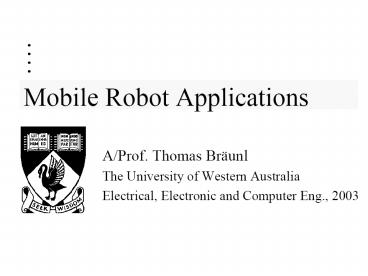Mobile Robot Applications - PowerPoint PPT Presentation
Title:
Mobile Robot Applications
Description:
MAZE was MODIFIED, this causes new algorithm needs This is becoming a competition for sensors, motors and crazy ideas. Algorithmic problems are already solved. – PowerPoint PPT presentation
Number of Views:103
Avg rating:3.0/5.0
Title: Mobile Robot Applications
1
(No Transcript)
2
- Mobile Robot Applications
- Textbook
- T. Bräunl Embedded Robotics, Springer 2003
- Recommended Reading
- 1. J. Jones, A. Flynn Mobile Robots, 2nd Ed., AK
Peters, 1999 - ? Hobbyists introduction, easy reading
- 2. R. Arkin Behavior-based Robotics,
- ? Overview of behavior-based robotics
- 3. Kernighan, Ritchie The C Programming Language
- alternatively ltany C programming bookgt
- ? C programming skills are important!
3
- Contents Topics
- Maze driving
- Micro Mouse Contest
- Mapping
- Driving in unknown environments
- Elementary Image Processing
- Edge detection, color detection, color blobs
- Robot Soccer
- autonomous agents
4
Mazes and Mapping
robot
Know where to go!
Place p
Explore while finding the connection.
5
More complex Mazes
- We won local competition in 1990
- Two our teams did not complete the run 2004
- This is a tough competitions as participants
spend much time and have much experience
6
- Follow the wall algorithm and what is wrong with
it
7
Idea Always follow left wall.2. MAZE was
MODIFIED, this causes new algorithm needs
8
- This is becoming a competition for sensors,
motors and crazy ideas. - Algorithmic problems are already solved.
9
Long rods for sensing
10
CELL BASED IDEAS
Cell-based maze for mapping and motion planning
11
In early contests you can win using this simple
algorithm. Next it was changed to make contest
more interesting
- This algorithm will not find the object in the
middle if there is much empty space around.
12
Follow left wall Algorithm
- Psd position sensor devide
Explore_left Many Probabilistic variants have
been created
x,y coordinates, dir direction
flags
See next page for these routines
PSDGet is from sensors
continued
13
turning
Going one cell
Depending on current direction, update x and y
coordinates of the mouse
14
- Never finds the gold
- Idea to remember there are good special
algorithms for some kinds of mazes. - If you deal with general space or irregular map
of labyrinth, you have to use several algorithms
and adapt.
There are many recursive algorithms, we will
illustrate one of them
15
- Left-wall algorithm versus Recursion
16
Left wall following
recursion
Check all possibilities and backtrack
17
Backtracking!!!
In backtrack point robot knows that it has done a
bad decision
- This explains and illustrates the concept of
backtracking that is fundamental to robotics and
AI
18
Explore will call itself recursively
Mark x and y position
Check situations if front open etc Set flags
front open etc
Use flags front open etc
19
Recursive call of itself
This part shows recursive calls in all situations
Front open, Left open and right open
20
- Idea combine various maze algorithms
21
We can combine recursion and left -wall-following
algorithms in several ways
22
- Discuss how it works.
- How it is represented.
- This map shows calculating distances from the
start for labyrinth from bottom left
Using grid we start from here and go everywhere
adding 1 at each step
One approach to solve this are the Flood Fill
Algorithms
23
- Flood Fill algorithms
24
Flood Fill Algorithm Example
Phase 3
Phase 2
Phase 1
This is like the breadth first search
25
Flood Fill Algorithms
- The idea of marking cells appears here again
26
Algorithm continued
27
continuation
Example on next slide
28
- Shortest Path
- algorithms
29
Next Stage of Flood Algorithm Shortest Path
- Now we have
- Explored the maze
- Know the distance to goal from every cell
- Missing
- Shortest path from start to goal
- Idea
- Generate shortest path from goal backward to
start
30
Backtracking to (0,0)
31
- i,j cooridnates
- k current position
- Wall wall
north
south
east
west
32
- Visualization is important for the
user-programmer to understand what happens. - It really helps!
What to visualize in maze algorithms
- Distances of cells from start position
- Part of map that has been covered so far
- Map of labyrinth
- Path already done by robot
33
Real-world mazes (hospitals, universities) and
labyrinths (forest, park, open battlefield)
- Applications in hospitals, museums, mines, big
government buildings.
Learn from counting the door or information on
walls
34
Navigation Algorithms
- Dijkstras Algorithm
- A Algorithm
- Potential Field Method
- Wandering Standpoint Algorithm
- Distbug Algorithm
35
Dijkstras Algorithm for all shortest paths
36
(No Transcript)
37
(No Transcript)
38
(No Transcript)
39
A Algorithm for shortest path
40
Estimation such as geometric distance
41
Near the goal estimated distances are real
distances, no obstacles
42
Potential Field Method
43
Potential Field Method for map creation
- Description
- Global map generation algorithm with virtual
forces. - Required
- Start and goal position, positions of all
obstacles and walls. - Algorithm
- Generate a map with virtual attracting and
virtual repelling forces. - Start point, obstacles, and walls are repelling,
- goal is attracting,
- force strength is linear to global object
distance, - robot simply follows force field.
44
(No Transcript)
45
(No Transcript)































